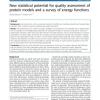Free Online Productivity Tools
i2Speak
i2Symbol
i2OCR
iTex2Img
iWeb2Print
iWeb2Shot
i2Type
iPdf2Split
iPdf2Merge
i2Bopomofo
i2Arabic
i2Style
i2Image
i2PDF
iLatex2Rtf
Sci2ools
BMCBI
2010
2010
New statistical potential for quality assessment of protein models and a survey of energy functions
Background: Scoring functions, such as molecular mechanic forcefields and statistical potentials are fundamentally important tools in protein structure modeling and quality assessment. Results: The performances of a number of publicly available scoring functions are compared with a statistical rigor, with an emphasis on knowledge-based potentials. We explored the effect on accuracy of alternative choices for representing interaction center types and other features of scoring functions, such as using information on solvent accessibility, on torsion angles, accounting for secondary structure preferences and side chain orientation. Partially based on the observations made, we present a novel residue based statistical potential, which employs a shuffled reference state definition and takes into account the mutual orientation of residue side chains. Atom- and residuelevel statistical potentials and Linux executables to calculate the energy of a given protein proposed in this work can be do...
| Added | 08 Dec 2010 |
| Updated | 08 Dec 2010 |
| Type | Journal |
| Year | 2010 |
| Where | BMCBI |
| Authors | Dmitry Rykunov, András Fiser |
Comments (0)

